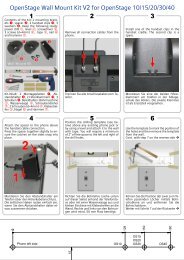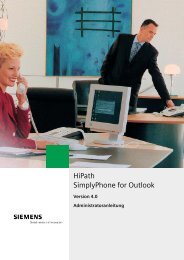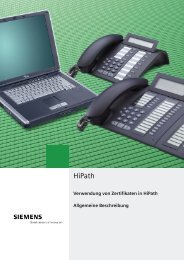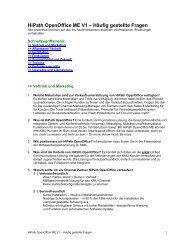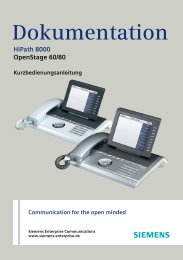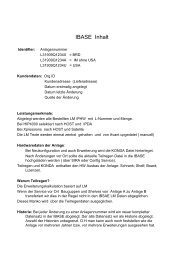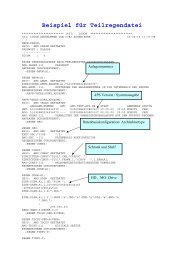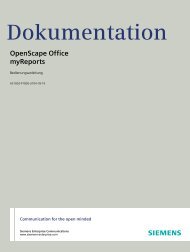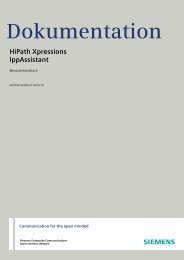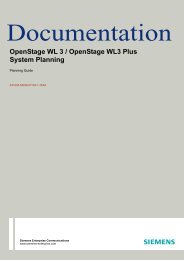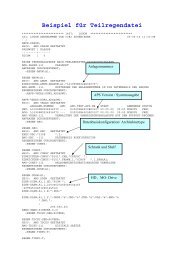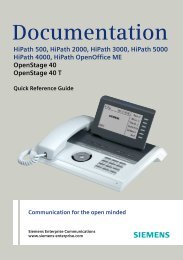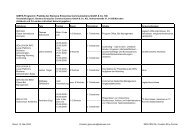User Manual optiPoint 500 HP500-HP3000-HP5000 - Siemens ...
User Manual optiPoint 500 HP500-HP3000-HP5000 - Siemens ...
User Manual optiPoint 500 HP500-HP3000-HP5000 - Siemens ...
You also want an ePaper? Increase the reach of your titles
YUMPU automatically turns print PDFs into web optimized ePapers that Google loves.
FCC and Industry Canada Compliance<br />
If at any time the ownership of <strong>Siemens</strong> <strong>optiPoint</strong> telephone is transferred to someone<br />
else (whether independently or as part of a system), please supply this manual to the new<br />
owner.<br />
1. REN<br />
The ringer equivalence number (REN) is used to determine the quality of devices which<br />
may be connected to the telephone line. Excessive RENs on the telephone line may<br />
result in the devices not ringing in response to an incoming call. In most, but not all areas,<br />
the sum of RENs should not exceed five (5.0). At the base of the telephone is a<br />
label contains, among other information, the REN and the FCC certification number. If<br />
requested, this information must be given to the telephone company. To be certain of<br />
the number of devices that may be connected to a line, as determined by the total<br />
RENs, contact the local telephone company.<br />
Note: REN is associated with the analog telephones. It is not applicable to <strong>Siemens</strong><br />
<strong>optiPoint</strong> telephone. If requested, please supply the FCC Certification numbers of the<br />
front-end host terminal equipment that have a direct Public Switched Telephone Network<br />
connection (i.e. have a REN stated on the label) and the highest REN.<br />
2. Facility Interface Information<br />
<strong>Siemens</strong> <strong>optiPoint</strong> telephone connects to the public switched telephone network<br />
through FCC Part 68 certified front-end host PBX equipment which specifies the type<br />
of network jacks to be used.<br />
3. Disruption of the Network<br />
If the <strong>Siemens</strong> <strong>optiPoint</strong> telephone disrupts the telephone network, the telephone<br />
company can discontinue your service temporarily. If possible, the telephone company<br />
will notify you in advance. If advance notice is not practical, they will notify you as soon<br />
as possible. You are also informed of your right to file a complaint with the FCC.<br />
4. Telephone Company Facility Changes<br />
The telephone company can make changes in its facilities, equipment, operations, or<br />
procedures that can affect the operation of your equipment. If they do, you should be<br />
notified in advance so you have an opportunity to maintain uninterrupted telephone service.<br />
5. Hearing-Aid Compatibility<br />
Telephones for emergency use and telephones installed in common areas such as lobbies,<br />
hospital rooms, elevators, and hotel rooms must have handsets that are compatible<br />
with magnetically coupled hearing aids. Persons who are not in common areas<br />
must also be provided with hearing-aid compatible handsets, if needed.<br />
The <strong>Siemens</strong> <strong>optiPoint</strong> telephone complies with the FCC Rules, Part 68, Section<br />
68.316 Hearing Aid Compatibility and 68.317 volume control requirements.<br />
6. Programmed Dialer Features<br />
When you program emergency numbers or make test calls to emergency numbers using<br />
<strong>Siemens</strong> products with programmed dialer features, stay on the line and briefly explain<br />
to the dispatcher the reason for the call before hanging up. Perform these activities<br />
in off-peak hours, such as early morning or late evening.<br />
139




